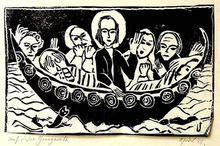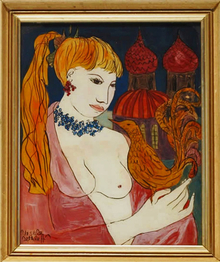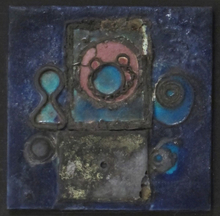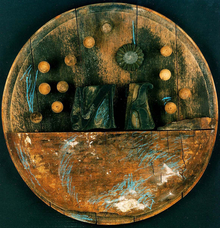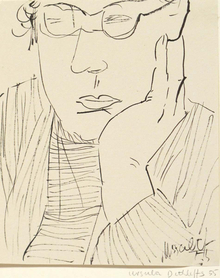- Home
- Works in Exhibitions
- Fridel Dethleffs-Edelmann
- Ursula Dethleffs
- Treasures from the Collection
- Collection of art
- Watercolor
- Tapestry
- Collage
- Gouache
- Reverse glass painting
- Glass church window
- Glass Mosaic
- Ceramic Plate
- Ceramic Picture
- Ceramic Relief
- Ceramic Sculpture
- Mixed media
- Object Art Relief
- Object Art Sculpture
- Oil Paintings
- Repro Lithography
- Repro Glass Lithography
- Repro Woodcut
- Repro Linocut
- Repro Monotype Printing
- Repro Etching
- Tempera
- Drawing Brush
- Drawing Brush Repro
- Drawing Ink and Pen
- Drawing Crayon
- Drawing pencil and crayon
- Exhibition by Period
- FDE: Selfportraits
- Introduction to the work of Ursula Dethleffs
- The collage as a total artwork
- Biography
- Dethleffs Gallery
einzigartig
Fridel Dethleffs-Edelmann
Ursula Dethleffs
Fridel Dethleffs-Edelmann
Ursula Dethleffs


Introduction into the work
By Dr. Ursula Merkel and Dr. Monika Scholl
from the book "Fridel Dethleffs-Edelmann and Ursula Dethleffs - An Overview", 1997
Ursula Dethleffs extensive, artistic creation proves to be impressively diverse already in her youth. In doing so, the safe formal design walks along with technical perfection. During the course of her life she had created reverse paintings behind glass, graphic works, cermamics, tapestries as well as wood reliefs and wood sculptures.
The balance of composition, formal security in the implementation, creative phantasy and a recognisable expressiveness already mark the early wood and linocuts of the 1940s and 50s. They impress through their simple, design that emphasises the surface and seems to be inspired by the art of Gaugin and the expressionists. Preferred themes in this period of creation are female acts, single or in groups, as well as biblical scenes.
The so to speak fairytale mood of many of these compositions and the internalized expression of single figures can also be found in the reverse glass paintings that are created in this period. Further themes are besides the motiv of a pair of lovers and the self-portraits, the world of the circus and cheerful fair artworks being rich in figures and captured in a series of etchings and colourful reverse glass painting.
By 1955, the artistic language of Ursula Dethleffs changes continuously: Religious depiction moves to the background, the view on motives becomes more direct and tends to be abstract – this can more and more distinctively be seen in the lithographs and drawings.
In a whole series of artworks using different techniques, the artist subsequently made a step towards a consequently abstract imagery, at the same time she also picks up figurative concrete motives again and again. She tried new creative design possibilities surprising in their result by painting over photographic reproductions. In the 1960s she created a series of paper collages, unfolding their own aesthetics with the flair of brittle poetry.
The first tapestries of Ursula Dethleffs are already created in her youth: Textile applications on a picking underground, that can be characterised as sewn images. High handicraft perfection and a harmonious formal design mark these early works.
Yet soon her particular interested is devoted to the structure and character of the used textiles. In the 1960s abstract colour compositions are created, being reminiscient of vegetal shapes. Calmness and balance charactersie the interplay of surfaces, shapes, colours and structures, causing new and always different reactions in every of these artworks.
During the 1970s Ursula Dethleffs stops to create the picturesque textile designs. She starts to break up the surfaces of her tapestries. The vivid coexistence and the one-above-each-other, showing and hiding different, colourful but also plain textile structure shapes increases the reduced design. In addition, non-textile materials, like e.g. buttons, cords, little chains or brooches serve as highlighting details and strengthen the dynamic of the composition. The artworks concentrating on women are an example for this period of creation.
When it comes to tapestries, Ursula Dethleffs finally frees herself completely from the pure flat kind of design. She turns, bulges, drapes and creates cnewls with the most different textiles, so that thick upholstery, fine strings or draperies unite to become a strongly moved, powerful relief. In the focus of her work remains the theme of showing and hiding. The game of light and shadow gives the strong and yet balanced dynamic of these textile image reliefs a lightness and more plasticity.
Since her youth, Ursula Dethleffs also has been working with ceramics. Since the beginning her artistic interest is devoted to the creation of ceramic surfaces. Her earliest work, a filigree vessel decoration in sgraffito technique that is manufactured with masterful security, she created already at the age of 12 years.
In the following period, also fireclay plates and split clinkers serve her besides tiles in different sizes as picture carriers. The painted image tiles she creates during the 1950s soon do not fulfill her artistic demands anymore. Her interest lies now in the glazing and the design possibilities, that are created through the impredictability of the burning process. At first, she creates colour compositions, in which she melts different coloured glazings. Various kinds of surfaces melt into each other, new types of glazings and structures form a new unit: Dense, glassy and yet transparent surfaces with craquele meet fine, dense surfaces, other flow out transparently. The tile images appear to be spontaneous and powerful getting their unique character through the integration of incalculable randomness of the glazing flow.
In the ceramic material relief images Ursula Dethleffs frees herself completely from the flat, picturesque treatment of surfaces. Thus she finds new approaches in both technically and in terms of design by integrating non-ceramic materials in her compositions and burning them together with the glazing: One recognises finds made of metal, like e.g. screws, metal sieves or nets, but also pieces of broken china or ceramic burning and plastic residues.
You can also find a bent sheet, a lock, a tin opener or screws in a golden blue fond. The effect of the ceramics create in contrast different, structured shades of grey with baked in clay pieces. A burned structure is set against the baked in wire netting as a remnant of set pieces and the blue surface.
The shortest period of creation was dedicated to the wooden artworks. They were here focus in the late 1980s. Installations were created, for which she used finds, that means, old, used, sometimes disassembled objects which she then put into a new context. The unadorned traces of use but also decline of the objects used which were only rarely changed in their shapes, represent an important design characteristic.
With these significant wood reliefs also a barrel cover or a wooden cupboard door serve as picture carrier: The artist here arranges rough wood or metal parts with complete devices. Cut motives create on the round relief a positive-negativ effect. Blue chalk lines or a flower drawn with chalk form a picturesque fine contrast to the powerful relief composings.
Primarily finds shaped by nature or wooden parts already marked by decline positioned on a wooden board made of three planks provoke the archaic effect of the relief.
What all wooden sculptures have in common is Ursula Dethleffs' confrontation with the theme "man". Upright standing old bars and squared timber form a torso, that is complemented by a few terse finds. For Ursula Dethleffs this is about the awareness of the human being by focusing on the elementary resp. the original. The static calmness of the almost archaic design, which lies in the simple, reduced shapes, gives the wood sculpture a particular significance
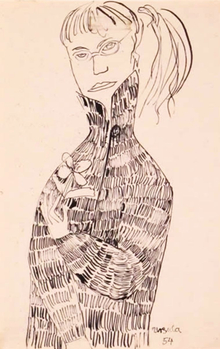
WVZ-No. 273012
